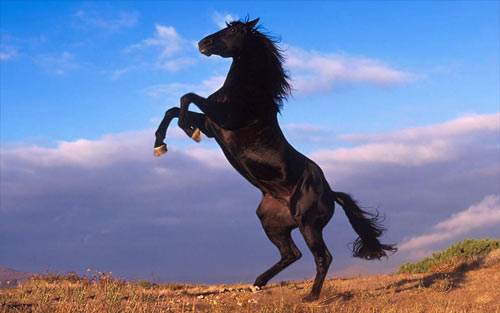马在古代曾是农业生产、交通运输和军事等活动的主要动力。在英语中也有关于描写马的作文题材,那你想知道描写马的作文英语怎么写吗?下面是小编收集整理的一些描写马的作文英语,大家一起来看看吧!
描写马的作文英语篇一:
Unlike ancient artists obsessed with saddled horses, Xu Beihong preferred feral and wild ones. Trained in France, the Chinese master studied equine anatomy, spending hours observing horses’ movements and expressions. Xu’s portrayals of horses galloping or trotting past, in a rich variety of poses, are some of the most captivating of their kind. Using mostly black ink, they combine the best methods from East and West. The lines and brush strokes are simple, yet invariable evoke the essence of the animals.
古代的艺术家热衷于画被驯服的马,画家徐悲鸿却对画野马情有独钟。这位国画大师在法国进修期间学习了马的解剖,他花费大量的时间观察马的动态和表情。徐悲鸿画的马,有的飞奔,有的小跑,形态各异,非常有魅力。他画的马多是黑色,结合了中西方绘画手法,线条和笔画简单,但是每幅画所画的动物却都十分传神。

描写马的作文英语篇二:
There are all kinds of horses in the world. But one of them you can't ride. It doesn't live on land, but in the sea. It looks like the head of horse. So the people call it sea horse. In fact, the sea horse is a small fish. It likes to live in warm water. A sea horse stands up in the water when it swims.
Father horse carries the eggs to keep them safe in its pouch. When the eggs are hatched, the baby horses swim away.
世界上有各种各样的马。但其中有一种是你不能骑的。它没有生活在陆地上,而是生活照在大海里。它看起来像马的头。所以人们称它为海马。事实上,海马是一种小型鱼类。它喜欢生活在温暖的水体中。海马在水里漂浮的时候可以站立。
海马爸爸在它们的育儿袋中携带卵子来确保安全。当卵子孵化出来,海马宝宝会自己游走。
描写马的作文英语篇三:
Hippopotamus amphibius The hippopotamus is one of the world’s largest and heaviest land animals.It lives partly in water and partly on land.Although strictly a plant eater,the hippopotamus has massive jaws with formidable tusks.Hippos have an unpredictable temperament and are capable of biting through small boats and slicing crocodiles in two.Hippos trample riverbanks and lakeshores,creating a maze of waterside paths and wallows that they use to get access to the plants they eat.Hippos spend their days lazing in or near water,emerging after dark to feed.
描写马的作文英语篇四:
The Name "Hippopotamus":"Hippopotamus" is a Greek combination of "hippo potamus" meaning "horse (of the) river." "Amphibeus" means "double life" in Greek,since the hippopotamus lives a life in the water and a life on land - just as the amphibious frogs and toads.
The hippopotamus is well adapted to an amphibious (two-lives:one in water and one out of water) life.It spends most of its time submerged in water.It emerges at sundown to feed on the grassy plains along the riverbank.It swims well,but usually walks on the river bottoms.It usually lives in groups of ten to fifteen individuals,but can mass in groups of thousands - especially in times of drought and few water holes.Little is known about the social structure.Hippos often fight violently with each other,frequently opening their mouths widely as a threat signal.
描写马的作文英语篇五:
The horse is a hooved (ungulate) mammal, a subspecies of the family Equidae. The horse has evolved over the past 45 to 55 million years from a small multi-toed creature into the large, single-toed animal of today. Humans began to domesticate horses around 4000 BC, and their domestication is believed to have been widespread by 3000 BC. Although most horses today are domesticated, there are still endangered populations of the Przewalski's Horse, the only remaining true wild horse, as well as more common populations of feral horses which live in the wild but are descended from domesticated ancestors. There is an extensive, specialized vocabulary used to describe equine-related concepts, covering everything from anatomy to life stages, size, colors, markings, breeds, locomotion, and behaviour.
Horses' anatomy enables them to make use of speed to escape predators and they have a well-developed sense of balance and a strong fight-or-flight instinct. Related to this need to flee from predators in the wild is an unusual trait: horses are able to sleep both standing up and lying down. Female horses, called mares, carry their young for approximately 11 months, and a young horse, called a foal, can stand and run shortly following birth. Most domesticated horses begin training under saddle or in harness between the ages of two and four. They reach full adult development by age five, and have an average lifespan of between 25 and 30 years.
Horse breeds are loosely divided into three categories based on general temperament: spirited "hot bloods" with speed and endurance; "cold bloods", such as draft horses and some ponies, suitable for slow, heavy work; and "warmbloods", developed from crosses between hot bloods and cold bloods, often focusing on creating breeds for specific riding purposes, particularly in Europe. There are over 300 breeds of horses in the world today, developed for many different uses.
Horses and humans interact in a wide variety of sport competitions and non-competitive recreational pursuits, as well as in working activities such as police work, agriculture, entertainment, and therapy. Horses were historically used in warfare, from which a wide variety of riding and driving techniques developed, using many different styles of equipment and methods of control. Many products are derived from horses, including meat, milk, hide, hair, bone, and pharmaceuticals extracted from the urine of pregnant mares. Humans provide domesticated horses with food, water and shelter, as well as attention from specialists such as veterinarians and farriers.

